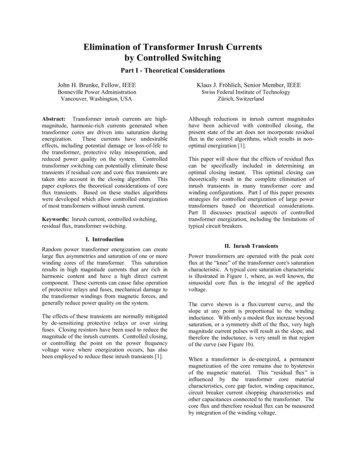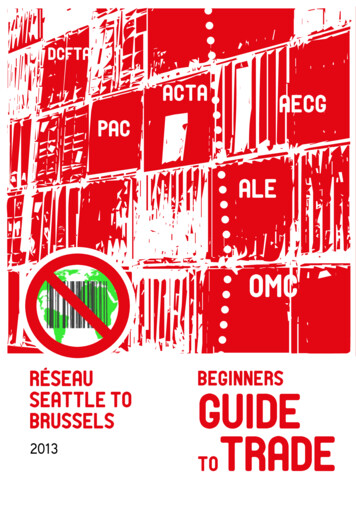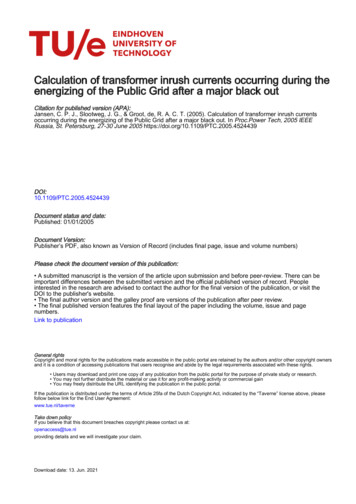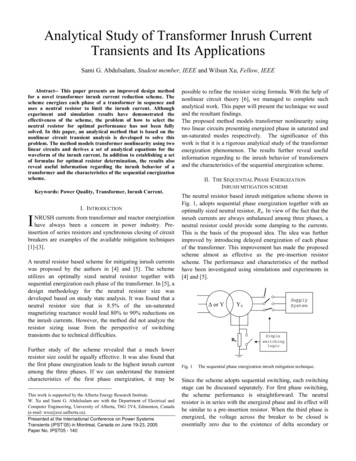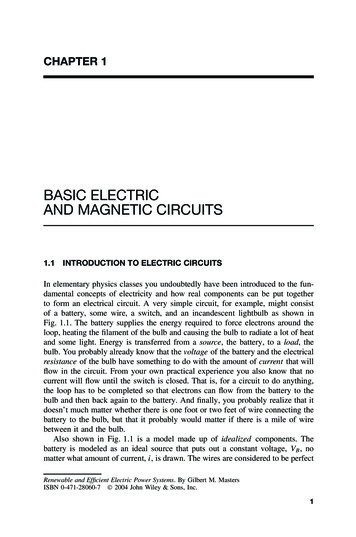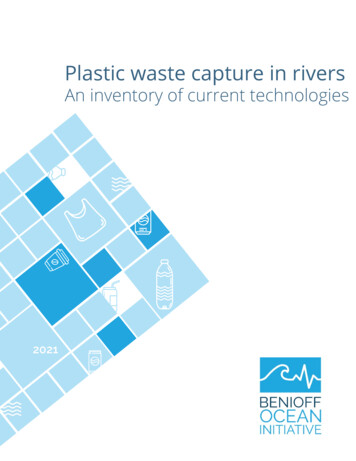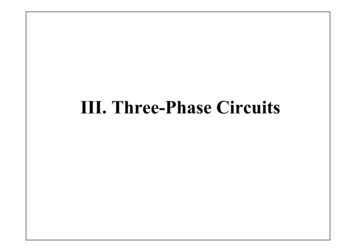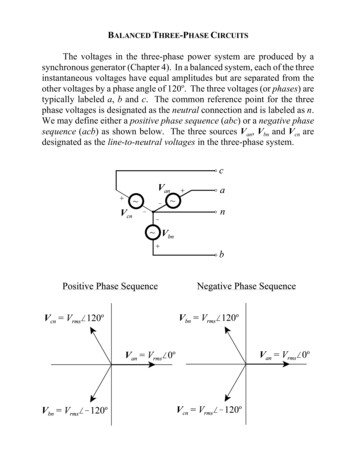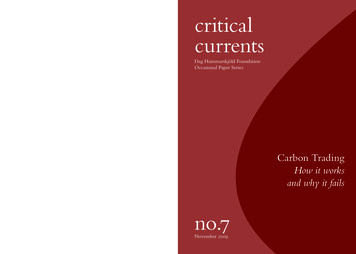
Transcription
Carbon trading lies at the centre of global climate policy and is projectedto become one of the world’s largest commodities markets, yet it has adisastrous track record since its adoption as part of the Kyoto Protocol.Carbon Trading: how it works and why it fails outlines the limitations of anapproach to tackling climate change which redefines the problem to fit theassumptions of neoliberal economics. It demonstrates that the EU EmissionsTrading Scheme, the world’s largest carbon market, has consistently failedto cap emissions, while the UN’s Clean Development Mechanism (CDM)routinely favours environmentally ineffective and socially unjust projects.This is illustrated with case studies of CDM projects in Brazil, Indonesia,India and Thailand.criticalcurrentsDag Hammarskjöld FoundationOccasional Paper SeriesUN climate talks in Copenhagen are discussing ways to expand the tradingexperiment, but the evidence suggests it should be abandoned. From subsidyshifting to regulation, there is a plethora of ways forward without carbontrading – but there are no short cuts around situated local knowledge andpolitical organising if climate change is to be addressed in a just and fairmanner.Carbon TradingHow it worksand why it failsCritical Currents is anOccasional Paper Seriespublished by theDag Hammarskjöld Foundation.It is also available onlineat www.dhf.uu.se.Printed copies may be obtained fromDag Hammarskjöld Foundation,Övre Slottsgatan 2SE- 753 10 Uppsala, Swedenemail: secretariat@dhf.uu.sephone: 46 (0)18-410 10 00no.7November 2009
critical currents no.7November 2009Carbon TradingHow it works and why it failsTamra Gilbertson and Oscar ReyesDag Hammarskjöld FoundationUppsala 2009
The Dag Hammarskjöld Foundationpays tribute to the memory of the secondSecretary General of the UN by searchingfor and examining workable alternativesfor a socially and economically just,ecologically sustainable, peaceful andsecure world.In the spirit of Dag Hammarskjöld’sintegrity, his readiness to challenge thedominant powers and his passionate pleafor the sovereignty of small nations andtheir right to shape their own destiny, theFoundation seeks to examine mainstreamunderstanding of development and bring tothe debate alternative perspectives of oftenunheard voices.By making possible the meeting of minds,experiences and perspectives through theorganising of seminars and dialogues,the Foundation plays a catalysing rolein the identification of new issues andthe formulation of new concepts, policyproposals, strategies and work plans towardssolutions. The Foundation seeks to be at thecutting edge of the debates on development,security and environment, therebycontinuously embarking on new themesin close collaboration with a wide andconstantly expanding international network.Critical Currents is anOccasional Paper Seriespublished by theDag Hammarskjöld Foundation.It is also available online atwww.dhf.uu.se.This issue of Critical Currents is publishedin cooperation with Carbon Trade Watch(www.carbontradewatch.org), the Transnational Institute (www.tni.org) and The Corner House (www.thecornerhouse.org.uk). Itis based on Carbon Trading: a critical conversation on climate change, privatization and power,edited by Larry Lohmann and published asDevelopment Dialogue no. 47 in 2006.Statements of fact or opinionare those of the authors anddo not imply endorsementby the Foundation.Manuscripts for reviewshould be sent tosecretariat@dhf.uu.se.Series editor: Henning MelberEditor: Larry LohmannCoordination andfinal text editing: Wendy DaviesDesign & Production: Mattias LassonPrinted by X-O Graf Tryckeri ABISSN 1654-4250Copyright on the text is with theauthors and the Foundation.
PrefaceThe Copenhagen process must address thereality of the larger eco-systems challenge weface. Healthy ecosystems are a precondition forstabilising the climate system. But the currentnegotiations are not addressing critical issuesrelated to the resilience of ecosystems and toecosystem services and are thus seriously flawed.1During the autumn of 2006 the Dag Hammarskjöld Foundation, in collaboration withThe Corner House and the Durban Groupfor Climate Justice, published a pioneeringchallenge to what had become the core ofofficial international efforts to solve the evermore visible crisis concerning climate changeand the urgent need to reduce emissions.2Based to a large extent on the work of LarryLohmann, the publication was at the forefront of a necessary intervention to demystifythe dominant exit options on offer – whichwere only ending in another cul de sac.Since then, public awareness has becomemore sensitised to the problems of treatingcarbon trading as a ‘silver bullet’ for solvingthe climate crisis. Common sense shouldalready suggest that things are not so simple:setting up a market in a new commodity isbound to be an invitation to traders to focustheir ingenuity on profit-seeking even if theresults undermine climatic stability.Our publication soon became a standardreference book, and we registered recordhits on our website.3 The huge demand alsoresulted in a second imprint, after well over10,000 hard copies had been distributed. Ona more self-critical note, however, as necessary as the fundamental analysis was, thesizeable volume of 350 pages contributed aconsiderable carbon footprint through thepaper and energy needed for its distribution.In addition, while the book laid out convincing arguments, it was not the most effective tool for those who needed a conciseintroduction to the problem. The idea ofproducing an updated shorter version therefore emerged quite soon, though the projectrequired some time. Thanks to Oscar Reyesand Tamra Gilbertson and with the supportof Larry Lohmann, we are now able to offerthis briefer, updated input for the discussions around Copenhagen.At a time when carbon trading is still beingstrongly promoted as the central solution toclimate change, we continue to stress thatit is, instead, part of the problem. But thisvolume also does not hesitate to look forward and thereby complements a paralleleffort looking into the challenges beyondCopenhagen.4Meeting today’s climate challenges requiresa paradigm shift in our thinking and approaches. Market-based strategies havefailed. We need to demystify the claim thatprice incentives alone will fi x matters.Henning Melber12Bo Ekman, Johan Rockström and Anders Wijkman, Grasping the climate crisis: A provocation from theTällberg Foundation, Stockholm: Tällberg Foundation (undated, 2008/2009), p.17.Carbon Trading: A critical conversation on climate change,privatisation and power (Development Dialogue, no.48), Uppsala: The Dag Hammarskjöld Foundation,September 2006. Like all recent publications, thisvolume is accessible for free download at the Foundation’s website (www.dhf.uu.se).34The combined total number of downloads fromthe sites of the Corner House and the Foundationamounted to over 820,000 by October 2009, i.e.within three years.Ulrich Brand, Nicola Bullard, Edgardo Landerand Tadzio Müller (eds), Contours of Climate Justice:Ideas for shaping new climate and energy politics (CriticalCurrents, no. 6), Uppsala: Dag Hammarskjöld Foundation, November 2009.
AcknowledgementsSpecial thanks to everyone who helped withthis project.Thanks to Joanna Cabello, Ricardo Carrerre,Calyx Clagg, Tom Goldtooth, NiclasHällström, Nina Holland, Chris Lang,Marianne Maeckelbergh, Daniela Meirelles,Winfried Overbeek, Pavement, KittisakRattanakrajangsri, Pinelopi Sioni, and theDurban Group for Climate Justice.Review committee: Joanna Cabello, CarbonTrade Watch; Marcelo Calazans, FASE,Brazil; Ricardo Sequeiros Coelho,Universidade do Porto, Portugal; AlmuthErnsting, Biofuelwatch, UK; Justin Fong,Moving Mountains, China; Soumitra Ghosh,NESPON/NFFPFW, India; Tom Goldtooth,Indigenous Environment Network;Amaranta Herrero, Universitat Autònomade Barcelona; Jutta Kill, FERN, UK; IvonneYanez, Oilwatch Sudamerica; Joe Zacune,Friends of the Earth International.4Critical Currents no. 7Field research and Chapter 4: MarceloCalazans, FASE, Brazil; Nishant Mateand Soumitra Ghosh, NESPON andNFFPFW, India; Wiwied Widya Astuti andMr. Kaka; Jikalihari, Sumatra, Indonesia;Nantiya Tangwisutijit, and The Nam SongConservation Club, Thailand.
Chapter summaryChapter 1 »introduces carbon trading, how it worksand some of the actors involved.Chapter 2 »explores the origins and key actors involvedin building the architecture of emissionstrading.Chapter 3 »examines the performance of the EU ETSand finds that it has generously rewardedpolluting companies while failing to reduceemissions. Many of the scheme’s flaws, fromthe overallocation of permits to polluteonwards, are found to be fundamental to thecap and trade approach more generally.Chapter 4 »outlines the performance of the CDM andlooks at four case studies of CDM projectsin Thailand, India, Indonesia and Brazil; itargues that offsets projects, even those thatpromote renewable energy, will not be asolution to climate change.Chapter 5 »outlines what could work and waysforward for political organising aroundquestions of climate change.Carbon Trading – How it works and why it fails5
6Critical Currents no. 7
1 » IntroductionThe headlines tell the story. ‘Billions wastedon UN climate programme’.1 ‘Truth aboutKyoto: huge profits, little carbon saved’.2‘UN effort to curtail emissions in turmoil’.3‘The Carbon Folly: Policymakers’ Favourite Global Warming Fix Isn’t Working’.4‘European Union’s efforts to tackle climatechange a failure’.5 ‘The great carbon creditcon: Why are we paying the Third World topoison its environment?’6Behind these headlines lies a tale of thegrowing failure of the main tool that governments, fi nancial institutions and corporations have adopted to address climatechange. This is carbon trading – a multibillion dollar scheme whose basic premise isthat polluters can pay someone else to cleanup their mess so that they don’t have to.123456John Vidal, ‘Billions wasted on UN climateprogramme’, The Guardian, 26 May 2008, p.1.Nick Davies, ‘Truth about Kyoto: Huge Profits,Little Carbon Saved’, The Guardian, 2 June 2007, p.1.Jeff rey Ball, ‘UN Effort to Curtail Emissions inTurmoil’, Wall Street Journal, 12 April 2008, p. A1.Emily Flynn Vencat, ‘The Carbon Folly:Policymakers’ Favorite Global Warming Fix Isn’tWorking’, Newsweek, 12 March 2007Channel 4 Evening News, London, lead story, 7March 2007.Nadine Gouri, ‘The great carbon credit con:Why are we paying the Third World to poisonits environment?’, Daily Mail, 1 June using-pollution.htmlTamra Gilbertsonis a researcher withCarbon Trade Watch /Transnational Institute(TNI). She is a co-founderof the Durban Group forClimate Justice.Photo: Pinelopi SioniOscar Reyes is aresearcher withCarbon Trade Watch /Transnational Institute(TNI). He was formerly TNICommunications Officerand co-editor of RedPepper magazine.Photo: Tamra GilbertsonThis issue of Critical Currents examines whatcarbon trading is and why it was adopted inthe fi rst place. It tells the story of how, fromits global beginnings as part of the KyotoProtocol in 1997, carbon trading has failedto change the way we acquire and use energy, while short-circuiting demands for thefundamental reforms needed. In the process,it has rewarded polluters for continued pollution while at the same time causing socialand environmental injustice.Carbon Trading – How it works and why it fails7
Climate change: a genuine crisisNowadays, few people doubt that the climateis changing and that human activity is themajor cause. The evidence is ‘unequivocal’,according to the 2007 Fourth AssessmentReport of the Intergovernmental Panel onClimate Change (IPCC), an assessment thatsynthesises the research of 2,500 scientists.7The period from 1997 to 2008 includes the10 warmest years since global records beganin 1850, while average sea level rises are accelerating.8 The IPCC warns that if presenttrends continue unchecked, temperaturescould rise by over 6 degrees Celsius and sealevels by up to 60 centimetres globally by2100.9 This is a conservative estimate compared to more recent studies, which haveshown that the geological record of ice meltwas non-linear and responded more rapidly.10 The likely consequences of climatechange vary from region to region, but include widespread drought, desertification,flooding and glacial melt.This message now seems to be getting across.But global efforts to tackle climate change7Intergovernmental Panel on Climate Change,Summary for Policymakers of the Synthesis Report ofthe IPCC Fourth Assessment Report, IPCC, Geneva,November 2007, p.1.8 Goddard Institute for Space Studies, ‘GlobalTemperature Trends: 2008 Annual Summation’,16 December 2008; http://data.giss.nasa.gov/gistemp/2008/9 Intergovernmental Panel on Climate Change,Climate Change 2007: The Physical Science Basis Summary for Policymakers, February 2007, p.6; r4wg1-spm.pdf10 James Hansen, Makiko Sato, Pushker Kharecha,David Beerling, Robert Berner, Valerie MassonDelmotte, Mark Pagani, Maureen Raymo, Dana L.Royer, James C. Zachos, ‘Target atmospheric CO2:Where should humanity aim?’, Open Atmos. Sci.J., vol. 2, 2008, pp. 217-231. This study shows thatwhen temperatures increased to 2-3 degrees Celciusabove today’s level, 3.5 million years ago, sea levelsrose not by the 59 centimetres predicted by theIPCC but by 25 metres.8Critical Currents no. 7are failing badly, with large and accelerating global increases in greenhouse gas emissions in the decade since Kyoto, as well as athreefold growth in emissions from fossil fuels since the 1990s.11 This booklet will arguethat the market-based solutions advocated bymany politicians, celebrities, scientists andlarge NGOs compound the problem.There has never been a lack of materials oringenuity for dealing with climate change.Like many other social problems, globalwarming is a crisis created by the actions of aminority of the world’s peoples – what Ramachandra Guha and Madhav Gadgil havecalled the omnivores, the development-aidedclass of modern consumers.12 For the world’smajority, global warming remains a problemfor which they already have the solution: forgoing excessive use of fossil fuels. The recentWestern fashion for distancing responsibilityfor climate change, both spatially and temporally, by attributing it to future car-hungryChinese or Indians, is a diversion possibleonly under the assumption – shared by elitesin North and South alike – that a society thatmandates over-consumption is the universalhuman destiny.Current global efforts to address climatechange, however, look absurdly inadequate.In 1997, the Kyoto Protocol saw 38 industrialised countries commit themselves to cutgreenhouse gas emissions by 2012 to a level5.2 per cent lower than those of 1990. At thattime, the IPCC suggested that there wouldneed to be a rapid 50 to 70 per cent emissionsreduction if the world were to stand a chanceof averting devastating climatic change. Ithas since revised its projection upwards.1311 For example, CO2 emissions rose by an average of3.2 per cent between 2000 and 2005.12 Ramachandra Guha and Madhav Gadgil, Ecologyand Equity, Penguin, London, 1995.13 Intergovernmental Panel on Climate Change,IPCC Second Assessment: Climate Change 1995,IPCC, Geneva, 1995.
Several more recent studies have argued thateven the latest IPCC figures are an underestimate. For example, James Hansen of NASA haspointed out that the IPCC’s earlier calculationfailed to take account of ‘slow feedback’ mechanisms that increase temperature rise caused bygreater greenhouse gas concentrations.14 Moregenerally, in their attempts to meet politicaldemands that a single unit be devised throughwhich the climate impact of one greenhousegas can be compared simply with another, andthen bought and sold in the form of pollutionpermits, scientists have downplayed the unpredictable, complex and non-linear impacts ofclimate change to render them easier for policymakers and markets to digest.Making climate problemsfit market solutionsIt was clear from the outset that the Kyoto Protocol was inadequate. Shortly after the treatywas signed, a scientific journal pointed out that30 Kyotos would be needed merely to stabilisethe concentration of carbon dioxide (CO2) inthe atmosphere at twice the level it stood at thetime of the Industrial Revolution.15But as a prerequisite for agreeing on evensuch an inadequate ‘solution’, the UnitedStates delegation then introduced into theKyoto negotiations a series of carbon trading proposals that served to undermine eventhe weak targets under discussion.The idea was to allow the industrialisedcountries included in the treaty, if they didnot want to make reductions domestically,to trade away these commitments for thepromise of emissions reductions in othercountries. The important point, so the theory went, was to achieve an overall balance14 James Hansen et al., op. cit., supra, note 10.15 David Malakoff, ‘Thirty Kyotos Needed to ControlGlobal Warming’, Science, 278, no. 2, 19 December1997, p. 2048.rather than insisting on each country meeting its own target. The ‘hidden hand’ of themarket would guide the process towards thecuts that were the cheapest to make.This loosened the lid that Kyoto itself hadplaced on industrialised countries’ emissions. For example, the industrial collapsethat took place in the former Soviet countries meant that they were already emittingfar less than in 1990. This provided a readysupply of ‘hot air’ emissions units (as theybecame known), releasing the pressure onthe North to make cuts domestically. Otherloopholes quickly appeared too.16Carbon tradingCarbon trading is a complex system whichsets itself a simple goal: to make it cheaper forcompanies and governments to meet emissions reduction targets – although, as we willshow, emissions trading is designed in sucha way that the targets can generally be metwithout actual reductions taking place.Carbon trading takes two main forms: ‘capand trade’ and ‘offsetting’.What is cap and trade?Under a scheme called ‘cap and trade’, governments or intergovernmental bodies likethe European Commission hand out licenses to pollute (or ‘carbon permits’) to major16 These included the exclusion of international shipping and aviation from emissions reduction targets.Official UN statistics show that fuels sold for usein international aviation and international marinetransportation increased by 65.9 and 18.4 per cent,respectively in the period from 1990 to 2006. Thesefigures refer only to transport originating from orarriving in Annex 1 countries (those with emissions reductions targets). See UNFCCC, ‘Nationalgreenhouse gas inventory data for the period1990–2006’, November 2008, p.12; fCarbon Trading – How it works and why it fails9
industries. Instead of cleaning up its act, onepolluter can then trade these permits with another who might make ‘equivalent’ changesmore cheaply. This is the approach underlying the European Union’s Emissions TradingScheme (EU ETS), the world’s largest carbonmarket, which was worth US 63 billion in2008 and continues to expand rapidly.17The theory is that the availability of carbonpermits will gradually be reduced, ensuringscarcity, so that the market retains its valuewhile at the same time forcing a reduction in the overall level of pollution. Thecap part is supposed to do the work, environmentally speaking, setting a legal limiton levels of permissible pollution within agiven time period. Each cap reduction is, ineffect, a new regulatory measure introducedby governments and/or international bodiesto restrict pollution further.The ‘trading’ (or ‘market-based’) componentof such a scheme does not actually reduce anyemissions. It simply gives companies greaterroom to manoeuvre in addressing the emissions problem, for which reason carbon trading proposals are sometimes also referredto as ‘flexible mechanisms’. Installations exceeding their reduction commitments cansell their surpluses to those who have failedto clean up their act adequately. Companiesthat want to keep on polluting save money,while in theory companies that are able toreduce beyond legal requirements will seizethe chance to make money from selling theirspare credits. But this flexibility comes at acost – what is cheap in the short term is notthe same as what is effective in the long termor environmentally and socially just.17 World Bank, State and Trends of the Carbon Market2009, World Bank, Washington DC, 2009, p.7.10Critical Currents no. 7In practice, the scheme has failed to incentivise emissions reductions. For example, acombination of industrial lobbying effortsand measurement difficulties have ensuredthat the pollution rights granted to privatefirms within cap and trade schemes are inmany cases more generous than the pollutersneed to cover their existing level of emissions.This surplus of permits can then be sold toother polluters so that they too might avoidreducing their greenhouse gas emissions.To date, the vast majority of permits havebeen handed out for free (a practice knownas ‘grandfathering’) in the EU ETS, andthe same is true for other cap and tradeschemes.18 The number of permits awardedis calculated according to existing levels ofpollution, which means that those who havepolluted most in the past are rewarded withthe greatest subsidy. This free gift of pollution rights to some of the worst industrialpolluters amounts to one of the largest projects for the creation and regressive distribution of property rights in history.1918 This is the case for the EU ETS until 2012. Although the EU and US have both claimed thatauctioning could provide a major revenue streamto fi nance other measures to tackle climate change,this has not yet materialised. In the USA, PresidentObama initially budgeted for US 646 billion as aresult of auctioning 100 per cent of carbon permits,but as of September 2009 it is proposed that around85 per cent be allocated for free. See Jim EfstathiouJr. and Kim Chipman, ‘Carbon Market BackersSplit Over Obama Climate Plan’, Bloomberg, 19March 2009; http://www.bloomberg.com/apps/news?pid 20601072&sid aVzbV8Sc35PY.The European Union also significantly watereddown its auctioning plans for the third phase of theEU ETS, with EU fi nance ministers vetoing callsfor the money to be ringfenced for climate-friendlypolicies. The largest single public revenue streamthat remains has been designated for the development of controversial ‘carbon capture and storage’technologies.
d19What are carbon offsets?The second type of carbon trading is offsetting.Instead of cutting emissions at source, companies, and sometimes international financialinstitutions, governments and individuals, finance ‘emissions-saving projects’ outside thecapped area. The UN-administered CleanDevelopment Mechanism (CDM) is the largest such scheme, with almost 1,800 registeredprojects as of September 2009, and over 2,600further projects awaiting approval.20 Based oncurrent prices, the credits produced by approved schemes could generate over US 55billion by 2012.2119 There is also a question of North-South distributionat stake here. Cap and trade schemes currently existin Northern countries, where governments awardthe pollution rights to companies that operate withintheir borders. For each year of its scheme, the EU hasawarded free emissions permits equating to almost2 billion tonnes of emissions – between 17 and34 per cent of the world’s ‘carbon dump’. Looselytranslated, this means the EU and companies operating there are in on the fact that they over-pollute –with a carbon price at 30 per tonne, the equivalentasset value would be approximately 60 billion. Aproposed cap and trade scheme in the USA, whichwould cover around 85 per cent of its emissions,would generate an even larger asset value – to besplit, most likely, between free passes for industryand revenue for the US government.It is worth noting, too, that this fundamental inequality in allocations is only marginally improved byauctioning the revenues rather than ‘grandfathering’them. When the EU and US plan to auction carbonrights and pay a proportion, the question remains: arethese their rights to sell? The defence that is typicallyused in response to this charge is that a proportion ofthe auction revenue will be allocated for developmentfunding, which tends to come with ‘conditionalities’.This is like owning a house with another person,selling it without their consent, then promising toreturn a small part of the money as long as they agreeto spend it according to criteria you define.20 UNEP Risoe CDM/JI Pipeline Analysis and Database, 1 September 2009, http://cdmpipeline.org/overview.htm21 This is based on a UNEP Risoe September 2009estimate of 279 million Certified Emissions Reductions (CERs) issued by 2012, and assumes a CER priceof US 20. CERs are the offset credits issued by theCDM.Although offsets are often presented as emissions reductions, they do not reduce emissions. Even in theory, they at most merelymove ‘reductions’ to where it is cheapest tomake them, which normally means a shiftfrom Northern to Southern countries. Pollution continues at one location on the assumption that an equivalent emissions saving will happen elsewhere. The projectsthat count as ‘emissions savings’ range frombuilding hydro-electric dams to capturingmethane from industrial livestock facilities.The carbon ‘savings’ are calculated according to how much less greenhouse gas is presumed to be entering the atmosphere thanwould have been the case in the absence ofthe project. But even the World Bank officials, accounting fi rms, fi nancial analysts,brokers and carbon consultants involved indevising these projects often admit privatelythat no ways exist to demonstrate that it iscarbon fi nance that makes the project possible.22 Researcher Dan Welch sums up thedifficulty: ‘Offsets are an imaginary commodity created by deducting what you hopehappens from what you guess would havehappened.’23 Since carbon offsets replace arequirement to verify emissions reductionsin one location with a set of stories aboutwhat would have happened in an imaginedfuture elsewhere, the net result tends to bean increase in greenhouse gas emissions.The use of ‘development’ and ‘poverty’rhetoric to describe offsets also masks theirfundamental injustice: offsets hand a newrevenue stream to some of the most highly22 Larry Lohmann, ‘Marketing and Making CarbonDumps: Commodification, Calculation and Counterfactuals in Climate Change Mitigation’, Science asCulture, vol. 14, no. 3, September 2005, pp. 203-235.23 Dan Welch, ‘A Buyer’s Guide to Off sets’, EthicalConsumer, no. 106, May/June 2007.Carbon Trading – How it works and why it fails11
polluting industries in the South, whilesimultaneously offering companies andgovernments in the North a means to delay changing their own industrial practicesand energy usage. As we show in chapter 4,carbon offset projects have resulted in landgrabs and the repression of local communities.Voluntary offsets, which give consumers inthe global North a means to make a payment to assuage their guilt about consumption, and companies the chance to presenta green face to the public, run into similarproblems. Offsets on the voluntary market exist outside UN regulation, but theyhave similarly negative consequences on thecommunities forced to endure them. In addition, these personal offsets individualisethe response to climate change, distillingthe complexities of a systemic problem ofhow energy is produced and used, and howland is distributed, into a seemingly simplequestion of authorising a small paymentwith the click of a computer mouse.24Putting a price on climate changeThese market-based approaches form akey part of the architecture for how international fi nancial institutions and governments propose to address climate change. Inthe words of the UK Government’s influential Stern Review on the Economics of ClimateChange, climate change is ‘the greatest market failure the world has ever seen’.25 Defi n24 Kevin Smith, The Carbon Neutral Myth: offsetindulgences for your climate sins, Carbon Trade Watch/Transnational Institute, Amsterdam, 2007.25 Nicholas Stern et al., Stern Review on the Economicsof Climate Change, HM Treasury, London, 2006,p.viii.12Critical Currents no. 7ing the problem in this way suggests that itis simply a market problem. New markets,Stern insists, can repair what existing markets broke. It is assumed that climate changeoccurred because no price was put on carbon, with the result that it was not valuedwhen economic decisions were made.This approach suggests that the earth’s capacity to regulate its climate can be treatedas a measurable commodity. The problemis that while commodity prices can domany things, one thing that they have neverachieved is to solve problems that requirestructural change in so many fundamentalareas of industry and agricultural practice. Amarket price for carbon, says Sussex University’s Energy Group’s Jim Watson, ‘is a verypoor weapon in what is supposed to be a warto save humanity’.26 In the 1970s, high pricerises did little to wean industrial societies offoil – and there is little reason to believe thata carbon price can do so either.The problem is, firstly, that price signals areuncertain – highly so in the case of existing carbon markets. Proponents of carbontrading argue that such markets could affectlong-term infrastructure decisions if only astable price signal could be achieved. Yetcarbon prices are inherently volatile. Thecommodity traded as ‘carbon’ does not actually exist outside of the numbers flashedup on trading screens or the registries heldby administrators. But a single tradable unitis needed in order to create a market, andfor this purpose a whole set of incommensu
political organising if climate change is to be addressed in a just and fair manner. Critical Currents is an Occasional Paper Series published by the Dag Hammarskjöld Foundation. It is also available online at www.dhf.uu.se. Printed copies may be obtained from Dag Hammarskjöld Foundation, Övre Slottsgatan 2 SE- 753 10 Uppsala, Sweden
